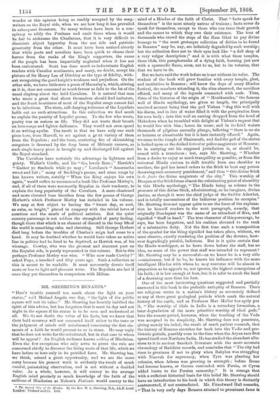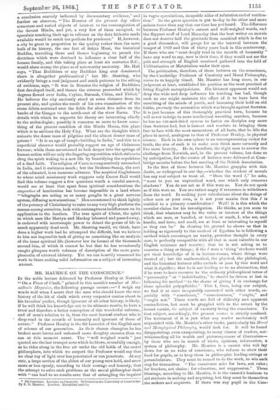MR. SIIERRING'S BENARES.*
4' DON'T trouble yourself too much about the light on your statue," said Michael Angelo one day, "the light of the public square will test its value." Mr. Sherring has heartily imbibed the spirit of this advice, but has forgotten that it must be day and not night in the square if his statue is to be seen and understood at all. We do not doubt the value of his facts, but we know that their bald accuracy will not commend itself either to the taste or the judgment of minds still uninformed concerning the first ele- ments of a faith he would present to us in stone. He may reply that he does not write for the uninitiated, but in that case to whom will he appeal ? An English audience knows nothing of Hinduism. Even the few exceptions who only serve to prove the rule are concerned chiefly to discover the living roots of that life, which we have before us here only in its petrified form. Mr. Sherring has, we think, missed a great opportunity, and we are the more sorry because his present work is evidently the result of much careful, painstaking observation, and is not without a decided value. As a whole, however, it will convey to the average English mind precisely as much knowledge of the faith of the millions of Hindostan as Nelson's Festivals would convey to the • The Sacred City or the Hindus. By the Bev. M. A. Shorting, M.A., LL.B. Lond. London: Triibnor and Co. 1868. mind of a Hindoo of the faith of Christ. That "facts speak for themselves" is the most utterly untrue of truisms ; facts never do speak for themselves, except to those who can trace their growth
and the causes to which they owe their existence. The tens of thousands who crowd the steps of the Earn Ghat to pay divine homage to "the most grotesque collection of deities to be found in Benares" may be, nay, are infinitely degraded by such worship ; but the collection does not to their eyes look like "a doll shop of a very vulgar description ;" and it is with what these temples, these idols, this paraphernalia of a dying faith, burning just now with a spasmodic flame, seem, not to us, but to its votaries, that that we have to do.
But we have said the work before us is not without its value. The student of the book will grow familiar with every temple, ghat, and institution in Benares ; will know the days of every Hindoo festival, the numbers attending it, the rites observed, the sacrifices offered, and many of the legends connected with each. Thus, three of the histories of the origin of " Manikarnika," the famous well of Hindu mythology, are given at length, the principally received account being that the god Vishnu "dug this well with
his discus, and in lieu of water filled it with the perspiration from his own body ; into this well an earring dropped from the head of Mahadeva when he trembled with delight at Vishnu's request that he would live with him ; hence its name, and in its fetid waters thousands of pilgrims annually plunge, believing "there is no sin so heinous or abominable but it is here instantly effaced." Again, we come to the temple of Bhaironath, and find the god of the shrine is looked upon as the deified kotwalor police magistrate of Benares ; he in carrying out his supposed jurisdiction is, or should be, armed with a truncheon ; but, says Mr. Sherring, " Whether from a desire to enjoy as much tranquillity as possible, or from the universal Hindu custom to shift trouble from one shoulder to another, the god has issued orders to the Stick to beat any person deserving such summary punishment," and thus "this divine Stick is de facto the divine magistrate of the city." This worship of Danpan or the Stick forms almost the culminating point of absurdity in this Hindu mythology, "The Hindu being as solemn in the presence of this divine Stick, administering, as he imaginal, divine justice, as though it were the chief judge of the Sadder Adawlut, and is totally unconscious of the ludicrous position he occupies." Mr. Sherring does not appear quite to see the force of the explana- tion he himself renders in the next paragraph, namely, that originally Dandapani was the name of an attendant of Siva, and signified "Staff in hand." The true character of this personage, he says, has been forgotten, and his emblem elevated to the rank of a substantive deity. Not the first time such a transposition of the symbol for the thing signified has taken place, without, we must observe, exactly rendering the position of the devotee, how- ever degradingly painful, ludicrous. But is it quite certain that the Hindu worshipper, as he bows down before the staff, has no idea, no sense of the power that staff was intended to represent? Mr. Sherriug may be a successful—as we know he is a very able —missionary, but if he be, he knows his influence with the more intelligent Hindus with whom he may converse will be almost in proportion as he appeals to, not ignores, the highest conceptions of his faith ; it is low enough at best, but it is safer to catch the head of a drowning man than his foot.
One of the most interesting questions suggested and partially answered in this book is the probable antiquity of Benares. There are religious strata in a nation's history as accurately defined as any of those great geological periods which mark the natural history of the earth, and as Professor Max Muller has aptly put it, "The worship of idols in India is a secondary formation, a later degradation of the more primitive worship of ideal gods." Into the remote period, however, when the teaching of the Veda was accepted in its simplicity, Mr. Sherring does not penetrate, giving merely his belief, the result of much patieut research, that the history of Benares stretches far back into the Vedic and pre- historic periods, possibly even to the time when the Aryan race first spread itself over Northern India. He has studied the abundant allu- sions to it in ancient Sanskrit literature with the more accurate chronology of Buddhist records, and concludes that "The city had risen to greatness if not to glory when Babylon was struggling with Niueveh for supremacy, when Tyre was planting her colonies, when Athens was growing in strength ; before Rome had become known, or Greece contended with Persia, or Cyrus added lustre to the Persian monarchy." It is strange that with a sufficient historical basis for this belief Mr. Sherring should have an introduction to his book in which this theory is distinctly controverted, if not contradicted. Mr. Fitzedward Hall remarks, "That in very early days Benares attained to prominent fame is a conclusion scarcely indicated by documentary evidence," and further on observes, "The Benares of the present day offers numerous and varied objects of interest to the contemplation of the devout Hindu, and yet, a very few of them excepted, to speculate touching their age in reliance on the data hitherto made available would be much too perilous for prudence." If, however, a city be great in proportion to the quality rather than the mere hulk of its history, the one fact of Sakya Muni, the historical Buddha, travelling there and thence beginning to preach the doctrines which were destined to influence a clear half of the human family, and this taking place at least six centuries B.C., would alone stamp the place as of noteworthy ancientry. Mr. Hall says, "That Buddhism or any Buddhist king ever dominated there is altogether problematical ;" but Mr. Sherriug, who evidently brings a cool judgment and much patience to the sifting of evidence, says, "It was in Benares the religion of Buddhism first developed itself, and thence the streams proceeded which by degrees flowed over India, Ceylon, Burinah, China, and Thibet." He believes the city anciently stood at some distance from its present site, and quotes the result of his own examination of the stone debris scattered over the fields for about five miles on the banks of the Ganges to the north-east of the river Barna. The details with which he supports his theory are interesting chiefly to the archmologist ; possibly it concerns us more to know some- thing of the present condition of this Hindu Mecca, this place which is to millions the Holy City. What are the thoughts which animate the dense mass of pilgrims and the almost denser mass of priests? "It is an age of temple-building in India," and this to a superficial observer would probably suggest an age of idolatrous fervour; while those accustomed to look deeper into the springs of human action will see only the lingering superstition which strives to drug the spirit waking to a new life by beautifying the sepulchres -of a dead faith. The religion of Caste is comparatively untouched in India, and it embraces much ; but the Brahmo-Sam4j, the sect -of the educated, is an immense advance. The sceptical Englishman to whose mind missionary work suggests only Exeter Hall would find this volume suggest a few questions worth a careful answer, would see at least that apart from spiritual considerations the stagnation of heathenism has become impossible in a land where "telegraphs are acting as so many ganglia in a great nervous system, diffusing new sensations." Men accustomed to think lightly of the potency of Christianity to raise to any very high platform the masses among ourselves, look with contemptuous indifference on its application to the heathen. The true spirit of Christ, the spirit in which men like Martyn and Mackay laboured and passed away, is endowed with microscopic power to detect the germs of life in much apparently dead seed. Mr. Sherring would, we think, have done a higher work had he attempted the difficult, but we believe to him not impossible task of giving us something like an analysis of the inner spiritual life (however low its forms) of the thousands around him, of which it cannot be but that he has occasionally caught glimpses worth volumes of description of the mere para- phernalia of external idolatry. Yet we can heartily commend his work to those seeking solid information on a subject of increasing nterest.































 Previous page
Previous page